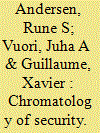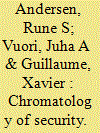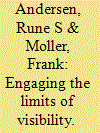|
|
|
Sort Order |
|
|
|
Items / Page
|
|
|
|
|
|
|
| Srl | Item |
| 1 |
ID:
141461


|
|
|
|
|
| Summary/Abstract |
The agenda of this article is to highlight how security becomes intelligible, is enacted, contested and (re)appropriated in part through colour use. Even though colours are a natural phenomenon, their meanings are societal products, and part of our constructed visibilities. These can be investigated through chromatology, the study of colour in relation to people. We illustrate this by applying multimodal social semiotics to view highly securitized sites, those of concentration and enemy-combatant camps. We show that the colour uses instituted to classify and govern prisoners not only structure the inmates socially, but also become vehicles for resisting the security discourses associated with them. The aim of the article is to highlight how security and international relations are intersemiotic relations, and to open up the study of security to an expanded range of semiotic modalities and methods of inquiry.
|
|
|
|
|
|
|
|
|
|
|
|
|
|
|
|
| 2 |
ID:
141780


|
|
|
|
|
| Summary/Abstract |
The agenda of this article is to highlight how security becomes intelligible, is enacted, contested and (re)appropriated in part through colour use. Even though colours are a natural phenomenon, their meanings are societal products, and part of our constructed visibilities. These can be investigated through chromatology, the study of colour in relation to people. We illustrate this by applying multimodal social semiotics to view highly securitized sites, those of concentration and enemy-combatant camps. We show that the colour uses instituted to classify and govern prisoners not only structure the inmates socially, but also become vehicles for resisting the security discourses associated with them. The aim of the article is to highlight how security and international relations are intersemiotic relations, and to open up the study of security to an expanded range of semiotic modalities and methods of inquiry.
|
|
|
|
|
|
|
|
|
|
|
|
|
|
|
|
| 3 |
ID:
121822


|
|
|
|
|
| Publication |
2013.
|
| Summary/Abstract |
In this article, we introduce selected photographs in order to engage with their capability for questioning the representational codes dominant in the visualization of security policy and surveillance. We argue that the intangible, abstract workings of state power in connection with security, surveillance and current forms of warfare can aptly be represented and challenged by means of photography. By engaging the limits of visibility, the selected photographs explore the limits of photojournalism and security alike. First, they operate by making visible what is normally invisible, though they also blur the boundaries of the seen and the unseen. Second, they function outside the discursive-representational regime within which photojournalism, based on a powerful tradition, operates, and within which media and security professionals visualize security. By so doing, they avoid involuntary incorporation into and support of this very regime that simultaneously they help understand. Third, they visualize structures and institutions rather than people, thus avoiding ethical dilemmas in connection with representations of people in pain. Discussing selected photographs by Trevor Paglen and Simon Norfolk, we show what these photographs do to alter the discursive frame within which the politics of security is understood. Such alteration facilitates understanding of the extent to which current societies are penetrated by the ideas and practices of security and surveillance, and furthers investigation of the discursive structures that enable such penetration.
|
|
|
|
|
|
|
|
|
|
|
|
|
|
|
|
|
|
|
|
|